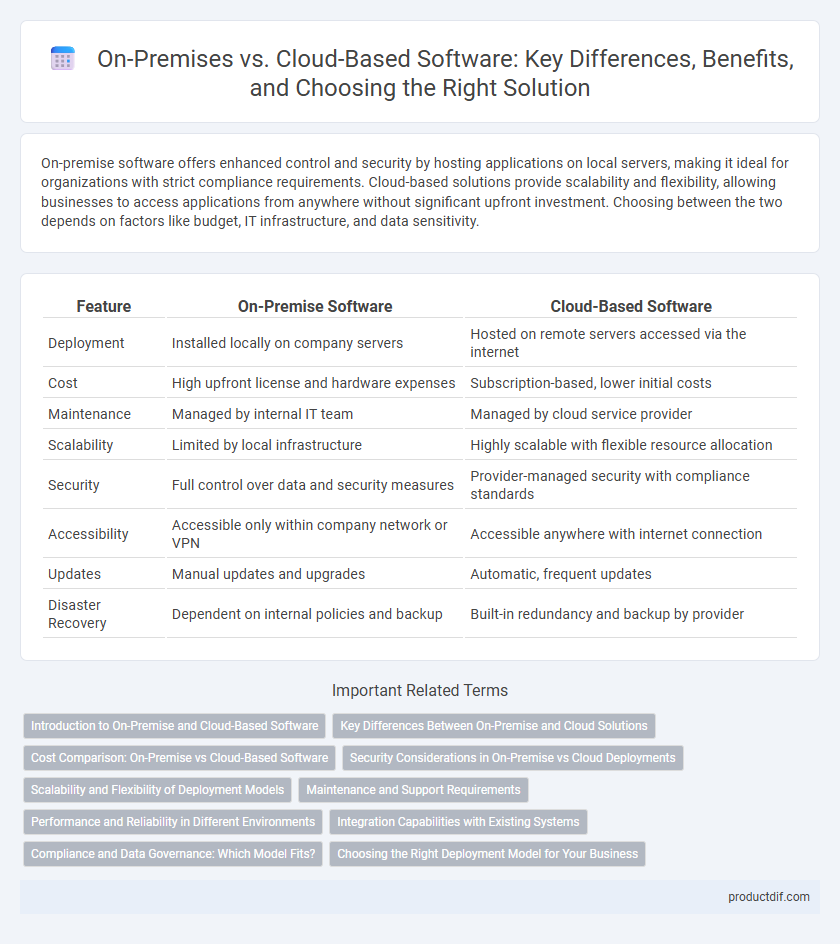On-premise software offers enhanced control and security by hosting applications on local servers, making it ideal for organizations with strict compliance requirements. Cloud-based solutions provide scalability and flexibility, allowing businesses to access applications from anywhere without significant upfront investment. Choosing between the two depends on factors like budget, IT infrastructure, and data sensitivity.
Table of Comparison
| Feature | On-Premise Software | Cloud-Based Software |
|---|---|---|
| Deployment | Installed locally on company servers | Hosted on remote servers accessed via the internet |
| Cost | High upfront license and hardware expenses | Subscription-based, lower initial costs |
| Maintenance | Managed by internal IT team | Managed by cloud service provider |
| Scalability | Limited by local infrastructure | Highly scalable with flexible resource allocation |
| Security | Full control over data and security measures | Provider-managed security with compliance standards |
| Accessibility | Accessible only within company network or VPN | Accessible anywhere with internet connection |
| Updates | Manual updates and upgrades | Automatic, frequent updates |
| Disaster Recovery | Dependent on internal policies and backup | Built-in redundancy and backup by provider |
Introduction to On-Premise and Cloud-Based Software
On-premise software is installed and operated directly on a company's local servers and hardware, offering full control over data security and customization. Cloud-based software runs on remote servers accessed via the internet, enabling scalability, automatic updates, and reduced upfront infrastructure costs. Choosing between on-premise and cloud-based solutions depends on factors such as compliance requirements, budget, and IT resource availability.
Key Differences Between On-Premise and Cloud Solutions
On-premise software requires local servers and infrastructure management, offering greater control and customization but higher upfront costs and maintenance responsibilities. Cloud-based solutions provide scalable, subscription-based access hosted on remote servers, reducing IT overhead and enabling rapid deployment and updates. Security management varies significantly, with on-premise demanding in-house expertise while cloud providers implement shared responsibility models and advanced security protocols.
Cost Comparison: On-Premise vs Cloud-Based Software
On-premise software requires significant upfront capital investment in hardware, infrastructure, and ongoing maintenance costs, while cloud-based software operates on a subscription or pay-as-you-go model, reducing initial expenses. Cloud solutions often lower total cost of ownership by eliminating the need for dedicated IT staff and continuous hardware upgrades. Scalability and flexibility in cloud environments can optimize operational costs compared to the fixed expenses associated with on-premise deployments.
Security Considerations in On-Premise vs Cloud Deployments
On-premise deployments offer direct control over security infrastructure, enabling customized firewall configurations and physical access restrictions that reduce exposure to external threats. Cloud-based solutions rely on provider-managed security protocols, including encryption, multi-factor authentication, and continuous monitoring, which benefit from dedicated cybersecurity teams and automatic updates. Data residency and compliance requirements often influence the choice, as on-premise setups simplify adherence to strict regulatory standards, while cloud deployments require thorough evaluation of the provider's certifications and data handling policies.
Scalability and Flexibility of Deployment Models
On-premise software offers limited scalability constrained by physical hardware capacity, requiring significant investment and time for upgrades. Cloud-based solutions provide dynamic scalability, enabling instant resource adjustments to meet fluctuating demands while supporting flexible deployment across multiple geographic locations. This flexibility accelerates innovation cycles and reduces infrastructure management overhead compared to traditional on-premise environments.
Maintenance and Support Requirements
On-premise software requires dedicated IT staff for regular maintenance, hardware upgrades, and troubleshooting, leading to higher ongoing support costs. Cloud-based solutions offer managed maintenance and automatic updates handled by the service provider, reducing internal resource demands. This shift minimizes downtime risk and accelerates issue resolution through integrated vendor support systems.
Performance and Reliability in Different Environments
On-premise software delivers high performance by leveraging dedicated hardware and local network infrastructure, minimizing latency and providing consistent resource availability. Cloud-based solutions offer scalable reliability through distributed data centers and robust fault-tolerant architectures, ensuring continuous uptime even during hardware failures. Performance in cloud environments can vary based on internet connectivity and service provider optimization, while on-premise relies heavily on internal IT maintenance and hardware upgrades.
Integration Capabilities with Existing Systems
On-premise software offers direct integration with existing legacy systems through customizable APIs and local network interfaces, ensuring seamless data flow and control within the enterprise infrastructure. Cloud-based solutions provide extensive integration capabilities via standardized web services and RESTful APIs, enabling real-time synchronization and scalability across distributed environments. Hybrid integration patterns are increasingly adopted to combine on-premise security with cloud flexibility, optimizing workflow continuity and operational efficiency.
Compliance and Data Governance: Which Model Fits?
On-premise software solutions offer greater control over compliance and data governance by enabling organizations to maintain data within their own infrastructure, ensuring adherence to industry-specific regulations such as HIPAA or GDPR. Cloud-based models provide automated compliance features and scalability but require thorough evaluation of the provider's certifications, data residency policies, and shared responsibility models. Choosing between on-premise and cloud hinges on the organization's risk tolerance, regulatory environment, and the complexity of managing internal versus external data controls.
Choosing the Right Deployment Model for Your Business
Choosing the right deployment model between on-premise and cloud-based software depends on factors like control, security, and scalability needs. On-premise solutions offer greater customization and data sovereignty, ideal for businesses with strict compliance requirements. Cloud-based platforms provide flexibility, cost-efficiency, and easy access to updates, making them well-suited for scalable and remote work environments.
On-premise vs Cloud-based Infographic

 productdif.com
productdif.com